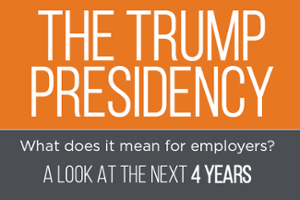 On January 20, 2017, President Trump signed an Executive Order on the Affordable Care Act (ACA). But if you think the ACA is gone - think again. No ACA provisions or requirements have been eliminated or delayed as a result of President Trump’s actions. Employers should continue to prepare for future requirements and deadlines to ensure full compliance.
On January 20, 2017, President Trump signed an Executive Order on the Affordable Care Act (ACA). But if you think the ACA is gone - think again. No ACA provisions or requirements have been eliminated or delayed as a result of President Trump’s actions. Employers should continue to prepare for future requirements and deadlines to ensure full compliance.
As his first act as President, Donald Trump signed an Executive Order that states it is intended to “to minimize the unwarranted economic and regulatory burdens” of the ACA until the law can be repealed and eventually replaced.
What does this mean to my organization?
Nothing yet. No ACA provisions or requirements have been eliminated or delayed at this time. The Executive Order is broad and does not address any particular ACA provision.
What is an Executive Order?
An Executive Order is a broad policy directive that is used to establish how laws will be enforced by the administration. In this instance, this Executive Order does not include specific guidance regarding any particular ACA requirement or provision and does not change any existing regulations.
What is the impact of this Executive Order?
It gives federal agencies broad authority to eliminate or fail to enforce some ACA requirements, as permitted by law. However, many of these agencies are not staffed yet. As a result, it is hard to know how the ACA will be impacted until the new heads of federal agencies are in place.
What’s next?
It’s still way too soon to tell. The ACA is a very complex piece of legislation and will take some time to unwind. Moving too quickly without long-term strategy or a replacement plan could impact coverage to roughly 20 million people and throw the health insurance market into turmoil - further driving up costs. Both of these scenarios will cause some elected officials to proceed very cautiously.
While President Trump committed during his campaign to fully repeal the ACA, he cannot do that by himself. He started the process on day one of his administration with his Executive Order. However, he is not able to fully outright repeal it - President Trump needs the help of Congress. Since Republicans do not have a 60-vote supermajority in the Senate, they also cannot outright repeal the ACA.
Democrats will be able to filibuster any ACA repeal plan and/or any repeal and replace plan. However, this executive order starts the ACA repeal process and strengthens the Republicans ability to use a process known as reconciliation, (which requires only 50 votes in the Senate), to eliminate most of the law's key provisions.
Currently, there are at least six Republican ACA replacement options that have been put forth. The Republicans may need time to unify and agree on one replacement option. If the past is any prediction of the future, employers may not see any significant ACA changes until after the 2018 Senate elections.
.png?width=69&height=53&name=Acrisure%20Logo%20(White%20Horizontal).png)


